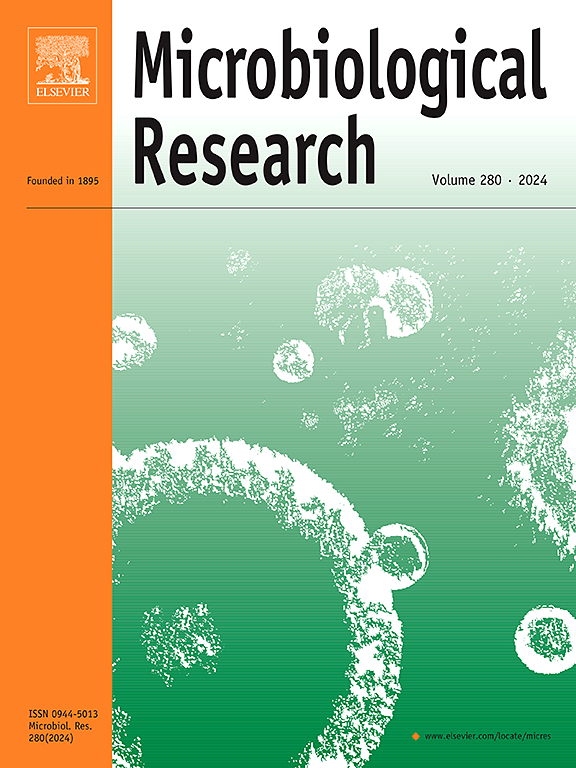病原菌激活的全球毛毛菌G3通过铁竞争等拮抗机制抑制玉米幼苗枯萎病致病菌黄萎病
IF 6.9
1区 生物学
Q1 MICROBIOLOGY
引用次数: 0
摘要
黄萎病菌(Fusarium verticillioides, F. verticillioides)是一种严重威胁玉米(Zea mays)生产的常见土传真菌病原体。毛藻属的物种被认为是管理植物病原体的潜在生物防治剂。然而,毛毛菌对玉米幼苗枯萎病的防治效果和潜在的抑制机制尚未得到全面的评价和充分的阐明。本研究表明,全球毛藻(C. globosum) G3将玉米幼苗上的黄萎病菌病指数从81.5 %降低到37.6 %,对黄萎病菌的生长抑制作用为79 %。双转录组学和代谢组学分析显示,当与黄斑F. verticillioides共培养时,C. globosum G3上调铁结合途径,增强铁载体铁胺的分泌。铁补充实验进一步表明,C. globosum G3通过更有效的铁竞争抑制F. verticillioides。此外,黄曲霉诱导了C. globosum G3超过60% %的糖活性酶和肽酶基因表达,导致纤维素酶、几丁质酶和蛋白酶活性增加,并产生抗菌化合物。此外,verticillioides下调与伏马菌素生物合成途径相关的基因,导致伏马菌素产量减少。这些结果表明,C. globosum具有作为玉米幼苗枯萎病病原菌verticillioides生物防治剂的潜力,并强调病原菌激活的C. globosum G3增强了铁竞争和其他拮抗机制,有助于抑制F. verticillioides。本文章由计算机程序翻译,如有差异,请以英文原文为准。
Pathogen-activated Chaetomium globosum G3 enhances iron competition and other antagonistic mechanisms to suppress maize seedling blight causal agent Fusarium verticillioides
Fusarium verticillioides (F. verticillioides) is a prevalent soilborne fungal pathogen that seriously threatens the production of maize (Zea mays). Species within the Chaetomium genus are recognized as potential biocontrol agents for managing plant pathogens. However, the biocontrol efficacy and underlying inhibitory mechanisms of Chaetomium species against maize seedling blight caused by F. verticillioides have yet to be comprehensively evaluated and fully elucidated. This study demonstrates that Chaetomium globosum (C. globosum) G3 reduced the disease index of F. verticillioides on maize seedlings from 81.5 % to 37.6 % and inhibited the growth of F. verticillioides by 79 %. Dual transcriptomic and metabolomic analysis revealed that when co-cultured with F. verticillioides, C. globosum G3 upregulated the iron binding pathway and enhanced the secretion of siderophore ferrioxamine. An iron supplementation experiment further indicated that C. globosum G3 inhibits F. verticillioides through more effective competition for iron. Additionally, over 60 % of the carbohydrate-active enzymes and peptidases gene expressions in C. globosum G3 were induced in response to F. verticillioides, resulting in increased activities of cellulase, chitinase, and protease, as well as the production of antibacterial compounds. Furthermore, F. verticillioides downregulated genes associated with the fumonisin biosynthetic pathway, resulting in reduced fumonisin production. These findings suggest that C. globosum holds potential as a biocontrol agent against the maize seedlings blight pathogen F. verticillioides and highlight that pathogen-activated C. globosum G3 enhances iron competition and other antagonistic mechanisms, contributing to the suppression of F. verticillioides.
求助全文
通过发布文献求助,成功后即可免费获取论文全文。
去求助
来源期刊

Microbiological research
生物-微生物学
CiteScore
10.90
自引率
6.00%
发文量
249
审稿时长
29 days
期刊介绍:
Microbiological Research is devoted to publishing reports on prokaryotic and eukaryotic microorganisms such as yeasts, fungi, bacteria, archaea, and protozoa. Research on interactions between pathogenic microorganisms and their environment or hosts are also covered.
 求助内容:
求助内容: 应助结果提醒方式:
应助结果提醒方式:


